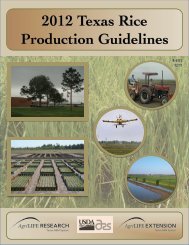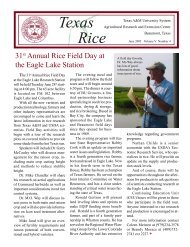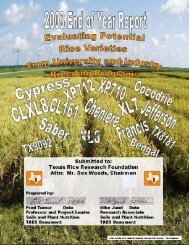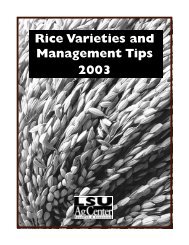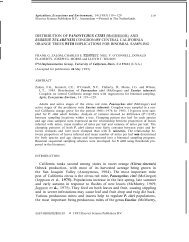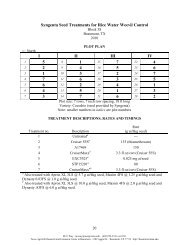2007 - Texas A&M AgriLIFE Research Center at Beaumont - Texas ...
2007 - Texas A&M AgriLIFE Research Center at Beaumont - Texas ...
2007 - Texas A&M AgriLIFE Research Center at Beaumont - Texas ...
You also want an ePaper? Increase the reach of your titles
YUMPU automatically turns print PDFs into web optimized ePapers that Google loves.
Although commercial long grain rice varieties lack<br />
significant levels of resistance to stem rot, the newer semidwarf<br />
varieties tend to be more tolerant to stem rot because<br />
of their resistance to lodging.<br />
Currently registered fungicides do not adequ<strong>at</strong>ely<br />
control stem rot and are not recommended for this purpose.<br />
Quadris ® and Tilt ® , when applied for she<strong>at</strong>h blight, can<br />
moder<strong>at</strong>ely suppress stem rot.<br />
Crop rot<strong>at</strong>ion and reduced r<strong>at</strong>es of nitrogen fertilizer in<br />
fields with a history of stem rot are recommended control<br />
practices.<br />
Narrow brown leaf spot<br />
Narrow brown leaf spot, caused by the fungus Cercospora<br />
janseana, causes more yield and grain loss than is often<br />
suspected. The fungus <strong>at</strong>tacks the leaf, she<strong>at</strong>h, uppermost<br />
internodes and glumes.<br />
On leaf blades, it causes short, linear, narrow, brown<br />
lesions parallel to the leaf veins. As plants approach m<strong>at</strong>urity,<br />
leaf spotting can become severe on the more susceptible<br />
varieties and result in severe leaf blighting and prem<strong>at</strong>ure<br />
de<strong>at</strong>h. Infection of the leaf she<strong>at</strong>hs result in a large brown<br />
blotch or “net blotch.”<br />
The fungus also can cause a “neck blight,” where the<br />
internodal area above and below the node <strong>at</strong> the base of the<br />
panicle becomes light brown to tan. The affected area dies<br />
and the kernels in the lower portion of the panicle fail to fill.<br />
Low nitrogen levels seem to enhance the disease.<br />
Tilt ® , Quadris ® , Str<strong>at</strong>ego ® and Quilt ® fungicides applied<br />
in the mid- to l<strong>at</strong>e-boot stage have been effective in suppressing<br />
the diseases caused by C. janseana.<br />
Table 16. Fungicides for rice foliar disease control.<br />
M<strong>at</strong>erial<br />
Gem 25WG<br />
Moncut 70WG<br />
R<strong>at</strong>e/A and timing<br />
8.0–9.8 oz @ PD-5 days to<br />
l<strong>at</strong>e boot<br />
8–16 oz @ PD AND PD+<br />
10–14 days<br />
She<strong>at</strong>h blight<br />
control 2<br />
7.5–8.0<br />
7–7.5<br />
Moncut 70WP 11–16 oz @ PD-5–10 days 6<br />
Propimax 10 f. oz @ PD to PD+10 days 5<br />
Quadris<br />
Quilt<br />
Str<strong>at</strong>ego<br />
9.2–12.3 fl oz @ PD+5 days<br />
to l<strong>at</strong>e boot<br />
14–34.5 fl oz @ PD+5 days<br />
to l<strong>at</strong>e boot<br />
14–19 fl oz @ PD+5 days to<br />
l<strong>at</strong>e boot<br />
8–8.5<br />
7.5–8.0<br />
7–7.5<br />
Tilt 10 fl oz @ PD TO PD+10 days 5<br />
1<br />
See product label for details on applic<strong>at</strong>ion r<strong>at</strong>e and timing.<br />
2<br />
She<strong>at</strong>h blight control r<strong>at</strong>ings 0–9.: 0 = no control; 9 = very good<br />
control<br />
Some other rice diseases for which fungicides have shown some efficacy<br />
include:<br />
Stem rot: Quadris 9.2–12.8 fl oz/A <strong>at</strong> PD to mid-boot.<br />
Kernel Smut: Tilt or Propimax 4.0–6.0 fl oz/A <strong>at</strong> l<strong>at</strong>e boot.<br />
Blast: Quadris 12.2 fl oz/A or Gem 6.4 to 9.8 oz/A <strong>at</strong> l<strong>at</strong>e boot and again<br />
<strong>at</strong> early heading when 50 percent of the main tillers have panicles 70<br />
to 80 percent of their length emerged but with the panicle bases yet<br />
unexposed. If only one fungicide applic<strong>at</strong>ion is used, the early heading<br />
applic<strong>at</strong>ion is often onsidered the preferable one.<br />
Panicle blanking complex<br />
Florets th<strong>at</strong> do not pollin<strong>at</strong>e or fill properly can result<br />
from of a number of biological and environmental factors.<br />
Often “blanked” florets can be numerous and result in significant<br />
yield losses. Completely empty florets indic<strong>at</strong>e th<strong>at</strong><br />
they never successfully pollin<strong>at</strong>ed.<br />
<strong>Research</strong> <strong>at</strong> <strong>Texas</strong> A&M and the Intern<strong>at</strong>ional Rice<br />
<strong>Research</strong> Institute (IRRI) has shown th<strong>at</strong> temper<strong>at</strong>ures<br />
above 95 degrees F during the pollin<strong>at</strong>ion process (anthesis)<br />
cause floret sterility. Another high-temper<strong>at</strong>ure sensitive<br />
period th<strong>at</strong> can cause pollen sterility occurs about 10 days<br />
before pollen shed.<br />
Early planting may be one way to reduce he<strong>at</strong>-induced<br />
sterility. He<strong>at</strong> sterility should not be confused with the disease<br />
called panicle blight.<br />
With panicle blight, florets often are pollin<strong>at</strong>ed but<br />
developing embryos abort, leaving a small embryo or undeveloped<br />
seed between the glumes. Upon close observ<strong>at</strong>ion a<br />
few days after panicle exertion, a lack of luster in the green<br />
glumes of the affected panicle can be noticed. Within 1 to 2<br />
weeks, the glumes turn various shades of tan to light brown<br />
and lack the turgidity and brightness of healthy glumes.<br />
Two important characteristics of panicle blight separ<strong>at</strong>e<br />
it from other panicle disorders:<br />
• Panicle blight often does not appear to prevent<br />
successful pollin<strong>at</strong>ion; and<br />
• The rachis or branches of the panicle remain green for<br />
a while right to the base of each floret, even after the<br />
glumes dessic<strong>at</strong>e and turn tan.<br />
Pollin<strong>at</strong>ion takes place and a small grain begins to<br />
form, but it aborts and remains small and underdeveloped.<br />
<strong>Research</strong> shows th<strong>at</strong> panicle blight is caused by a bacterium,<br />
Burkholderia glumae. Varieties with California germplasm,<br />
such as Cypress, Maybelle and Cocodrie, seem to be<br />
more prone to serious damage by panicle blight.<br />
Currently, the best way to manage panicle blight<br />
involves the use of timely planting, proper varietal choice<br />
and avoiding excessive seeding and nitrogen r<strong>at</strong>es. The<br />
copper-based product Top-Cop ® applied <strong>at</strong> 2 quarts per acre<br />
<strong>at</strong> l<strong>at</strong>e boot has suppressed panicle blight in field tests, but<br />
foliar phytotoxicity has been reported. If used, it is best to<br />
apply Top-Cop ® when the foliage is dry and without use of<br />
a surfactant.<br />
Ear blight is a disease complex caused by several fungi,<br />
including those th<strong>at</strong> cause narrow brown leaf spot (Cercospora<br />
janseana) and brown leaf spot (Cochliobolus miyabeanus).<br />
These fungi can cause discolor<strong>at</strong>ion and blight of<br />
the uppermost internodes, the neck below the panicle, the<br />
branches of the rachis, and spikelets of the panicles. This<br />
often results in poorly developed grains.<br />
Tilt ® , Quadris ® , Str<strong>at</strong>ego ® and Quilt ® applied in the midto<br />
l<strong>at</strong>e-boot stage help suppress this disease complex.<br />
Black she<strong>at</strong>h rot<br />
Black she<strong>at</strong>h rot or crown she<strong>at</strong>h rot is caused by the<br />
soil-borne fungus Gaeumannomyces graminis var. graminis<br />
and has been in <strong>Texas</strong> rice fields for <strong>at</strong> least several decades.<br />
–––––––––––––––––––––––––––––––––––––––––––––––––––––––––––––––––––––––––––––––––––– 31



